Turning Depot Repair into a Profit Engine

Published Date
Unplanned manufacturing downtime costs companies an average of $125,000 per hour. In some sectors, it climbs as high as $150,000. At the same time, aftermarket services generate twice the profit margin of new equipment sales. Reverse logistics is projected to exceed $1.6 trillion by 2030.
“Selling aftermarket services is, on average, at least twice as profitable as selling new units.” — Bain & Company, Service Profitability Report
Depot repair sits right at the center of these economics. Yet too many companies treat it like a cost center. That’s not just a missed opportunity. It’s leaving real money on the table.
Where Value Leaks Out
Depot repair often gets dismissed as “fix and ship,” but the reality is far more complex:
- Asset histories are incomplete, so warranty and entitlement claims slip through the cracks.
- Inventory is disconnected, causing delays, excess parts, and wasted spend.
- Failure data never makes it back to engineering, so problems keep repeating.
The result is a slow, fragmented process that hides in the background while eroding margin.
A Smarter Approach
The fix isn’t another spreadsheet or another point solution. It’s designing around outcomes from day one.
With ServiceNow CSM and FSM on a single data model, service teams can:
- Follow each asset from field to repair with a complete, connected history.
- Automate serialized part swaps and RMAs to cut turnaround time and cost.
- Give leaders real-time visibility instead of stale reports.
Put AI Where It Moves the Needle
AI and connected equipment deliver real ROI when focused on the few levers that matter most:
- Predict failures weeks ahead and route units before downtime escalates.
- Auto-trigger part orders to reduce waste and delays.
- Feed engineering and suppliers with clean failure data to stop repeat issues.
The goal isn’t more tech. It’s smarter service.
The KPIs That Separate Leaders From Laggards
Top service organizations don’t measure everything. They measure what matters:
- Turnaround time per unit and percent on-time completion
- First-time fix rate and repeat return rate
- Parts availability SLA and cost per repair
- Warranty recovery and entitlement accuracy
- Cost of inaction, tied to realistic downtime assumptions
These are the metrics that turn depot repair into a strategic lever, not a cost bucket.
Make the Change Stick
Winning teams bring depot staff in early, invest in training, and resist unnecessary customization. When the foundation is right, the payoffs are real: faster turns, higher recovery rates, lower cost per repair, and a service operation that fuels growth.
When depot repair runs efficiently, it doesn’t just save money. It drives uptime, captures lost margin, and strengthens the entire service business.
Book time with our team to map your depot repair opportunities.




